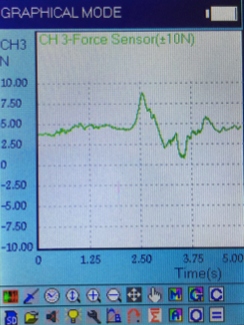In a recent IP3 class on Newton’s 2nd Law, the students were presented the “Elevator Problem” based on the THINK Cycle approach – a version of inquiry-based learning that was started in Temasek Junior College, Singapore.
The “Elevator Problem” is a physics phenomenon observed in an everyday experience that students can relate to quite easily. It is presented to our IP3 (K9 students) right after the introduction of Newton’s 2nd Law, with the students having a good understanding of the forces of weight and normal contact as well as what makes a resultant force.
TRIGGER
The THINK Cycle kicks off with a Trigger: a problem or phenomenon for which students have to solve or explain. In the “Elevator Problem”, the Trigger is the observation that as I stand on a bathroom scale in a lift going from one floor to another, the reading on the scale changes in such a way:
- When the lift starts moving, the reading on the scale increases momentarily.
- For most of the journey, the reading is constant.
- When the lift is stopping, the reading on the scale decreases momentarily
The video below (taken by myself) shows what happens:
The students are supposed to work in groups to explain this observation and hence, to deduce whether the elevator is on its way up or down.
HARNESS
In the Harness stage of the THINK Cycle, students would work in groups to answer some guiding questions to help them arrive at a conclusion:
- What are the forces acting on the boy?
- Which of these forces are constant and which can change?
- How does the motion of the lift affect the changing force?
- What force is the weighing scale showing?
I find that providing students with a small portable whiteboard or a few pieces of rough paper is necessary for them to represent their ideas in diagram form, especially when the objectives of this activity is best achieved with the help of free-body diagrams.
INVESTIGATE
After coming up with a hypothesis based on their discussions, they will then seek to verify their hypothesis. Task number 2, which is for students to determine whether the elevator is going up or down, can be tested by hanging a 500 g mass on a force meter attached to a datalogger. We use the Addestation aMixer in our school, which is a handy portable datalogger with a plug-and-play range of user-friendly sensors. It gives us a graph that looks like that shown below when the mass is being pulled upwards, thus confirming that the movement of the elevator is also upward.

The initial increase in tension acting on the mass is similar to that of the normal contact force on the man standing on the bathroom scale on the elevator. This is because both systems are accelerating upward.
The graph looks rather haphazard as the pulling is done manually and over a small height. By the time one pulls the mass up, he will have to decelerate already, which explains the dip in tension that follows right after the peak. Hence, we are unable to observe a stage where the tension is equal to weight, as we did for the scale in the elevator.
Nevertheless, students should be able to appreciate that a rise followed by a drop is observed for a mass being pulled upward.
NETWORK
For the sake of checking what the students have learnt collaboratively, each group is tasked to explain their observation and results on a A2-sized poster, with half the group staying at their own posters to answer questions while the other half going around to study the results from other groups. Their roles can be reversed after some time.
KNOW
In the final stage of our activity, the teacher will address the class and point out the common misconceptions that arose during the class discussions. For instance, many students are unaware that the upward force acting on the person standing on a weighing scale is the normal contact force and not the gravitational pull. This requires the teacher to introduce the terms “apparent weight” and “true weight” and making a distinction between the two.